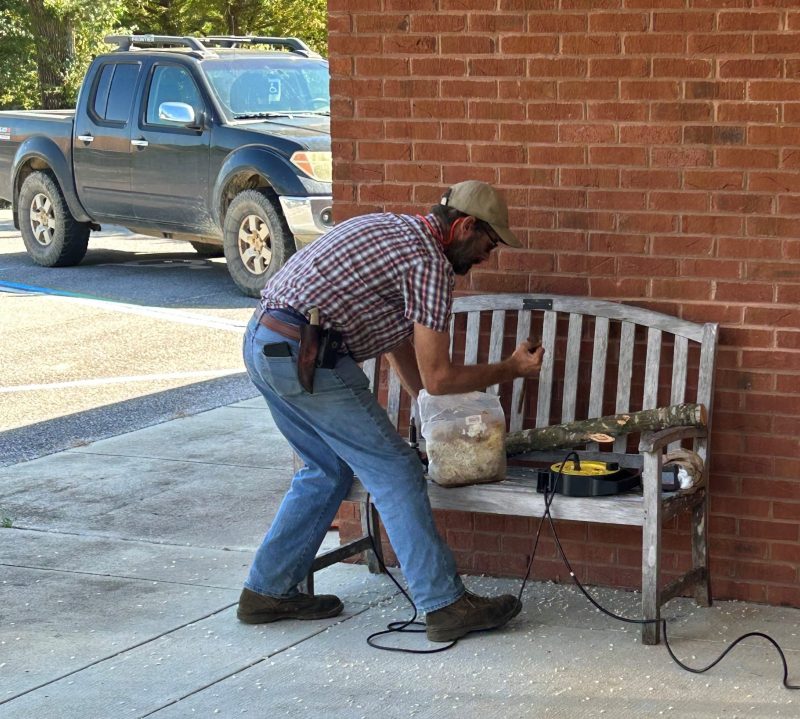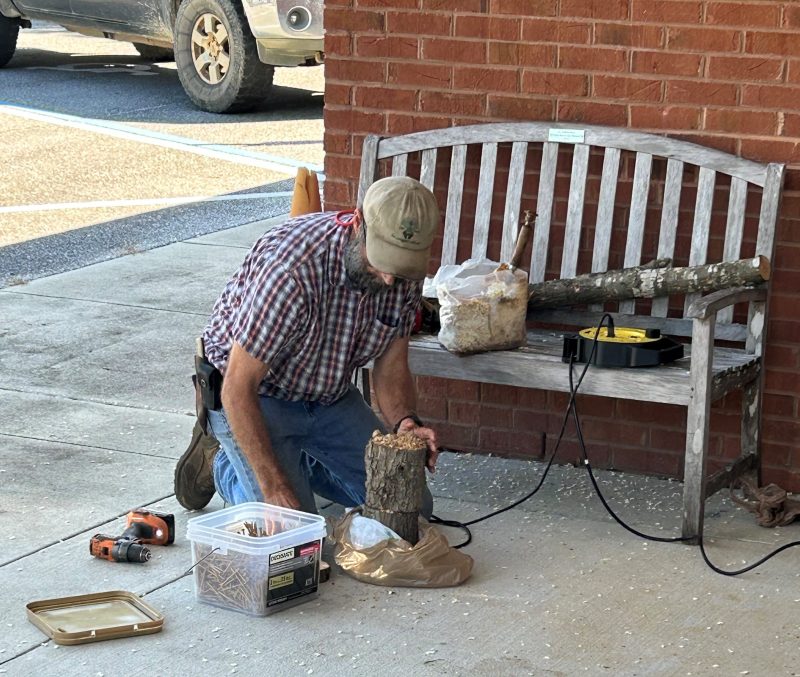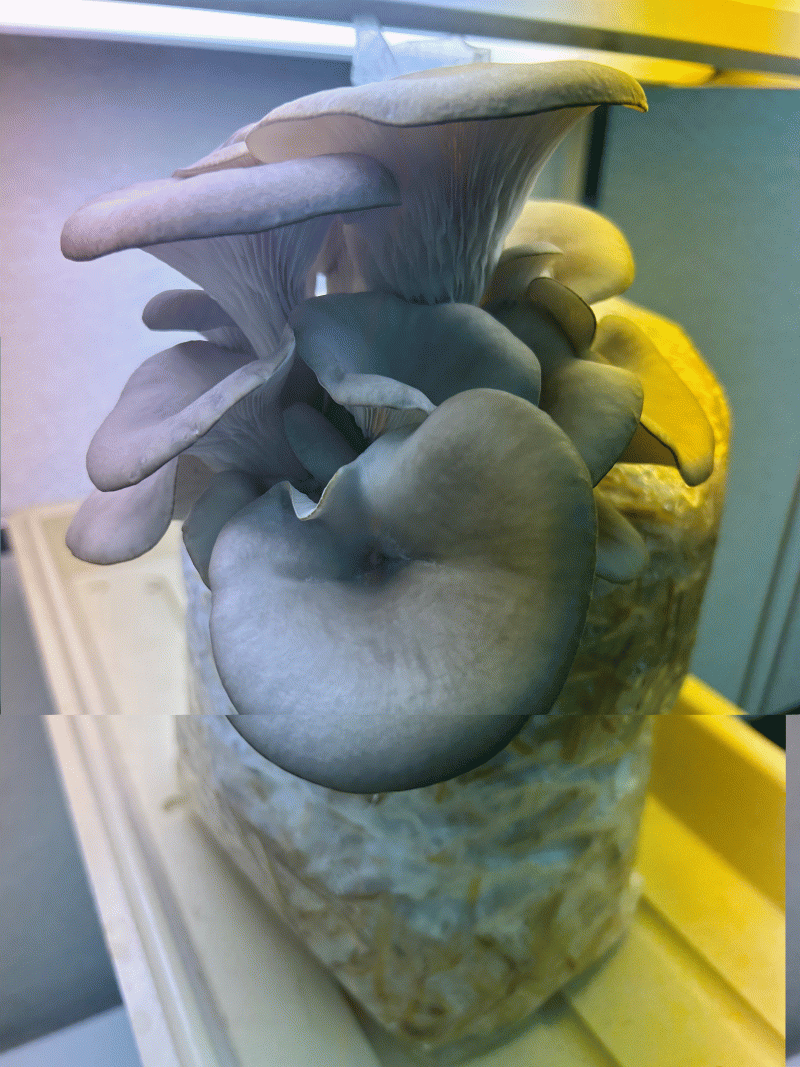Mushrooms aren’t the first crop that comes to mind when designating use of the back forty. However, it may be a crop to consider for spots with some tree cover. And mushroom production can bring in significant revenue to the farm, because shiitake mushrooms can be sold for ~$14/pound retail in our area. Just like any other type of farming, there are plenty of ways to grow a mushroom and plenty of species to grow.
–
Location, Substrate, and Species
Most cultivated mushroom species require shade for good production. Wooded areas are perfect for cultivation. Mushrooms can also be grown indoors or under covered structures. Depending on species, mushrooms are typically grown on cut logs or on a mix of sterilized straw and cotton seed hulls or other substrate. Mushroom farmers continue to experiment with different materials and tree species to grow mushrooms. Consider what media sources and tree species are available to you when determining how you want to grow mushrooms. You may be tired of cleaning up laurel oaks that seem to always fall during storms. Laurel oaks can be used to grow an assortment of shiitake mushroom strains. Sawtooth oaks and Chinese tallow (popcorn) trees are two other species commonly used for shiitake mushroom production. If you live near a cotton gin, then you may choose to grow mushrooms on cotton seed hulls. Oyster mushrooms can be grown on a mixture of cotton seed hulls and straw. Regardless of the method you choose, it’s important to know what time of year different species prefer and what strains do best in the Southeast.
-
Spring – Lion’s mane and some shiitake strains grow best in the spring.
– -
Summer – Black reishi, golden oyster, and summer white species grow best in the summer.
– -
Early Fall – Early fall is a good time to grow Italian oyster mushroom strains.
– -
Fall – Most oyster strains, lion’s mane, and early shiitake strains grow best in the fall.
– -
Winter – Most shiitake strains, lion’s mane, olive oysterling, nameko, turkey tail, and polar white mushrooms all grow well in the winter.
—
–
Production Methods and Materials
Log Production
Shiitake and some other species of mushrooms can be grown on freshly cut logs. Fleshly cut logs are required for this method because older material may already be inhabited by naturally occurring, native mushroom species. Logs with a 3-to-4-inch diameter should be cut to about 3 feet long. Holes are then drilled (spaced roughly 5 inches apart) down the length of the log in rows and spaced evenly around the log’s circumference to create a spacing of approximately one row per inch of log diameter. Mushroom spawn grown on wooden dowels or spawn grown on sawdust can then be inserted into the holes and sealed with hot wax. These inoculated logs are leaned against a railing or other structure in a shaded area and left until colonized by the fungi. Once logs are colonized by the mushroom mycelia, they are laid flat to encourage the mushrooms to fruit and produce the caps that we eat. This entire process can take several years depending on weather. For more information on this method, please visit Ohio State University’s Extension page.

Mark Hainds of Sweetbill’s Enterprises drilling holes in a soon-to-be inoculated mushroom log. Photo Credit: Matt Lollar, UF/IFAS Extension – Santa Rosa County
–
Totem Method
Another method utilizing unwanted timber is the totem method. This method can be adapted to more mushroom species than the log production method. Logs measuring roughly 6 inches in diameter are cut into two 8-to-10-inch-long sections and one 2-inch-thick section. Mushroom spawn impregnated on sawdust is sandwiched between the cut ends of the 8-to-10-inch-long sections and the sections are fastened together with toenailed screws. The mushroom spawn is then spread on the top cut side of the conjoined sections. The 2-inch-thick section is placed on top of the freshly spread spawn, fastened to the cut side of the middle section with a single screw, and additional spawn is spread on top. The newly built “totem” is wrapped in plastic grocery bags and sealed with tape until fruiting begins.

Mark Hainds of Sweetbill’s Enterprises constructing a mushroom totem. Photo Credit: Matt Lollar, University of Florida/IFAS Extension – Santa Rosa County
–
Bag Method
This is probably the simplest production method. Mushrooms can be grown on a variety of substrates including wheat straw, cotton seed hulls, and coffee grounds. These materials should first be pasteurized before being mixed with mushroom spawn. To pasteurize, soak the material overnight in water. Drain the excess water from the substrate, then place it in a bath of 165°F water for at least one hour. Allow the mixture to cool and drain/squeeze as much moisture out of the material as possible. Combine the pasteurized substrate with mushroom spawn at a rate of 5-10% volume/volume or weight/weight basis. The entire mixture is stuffed tightly in mushroom grow bags, produce bags, or any other suitable bag. Place the bag in a dark, cool spot that receives 80-90% humidity. This spot could be as simple as an empty cooler with the addition of an open container of water. In the right conditions, the mycelia with take about 2-to-3 weeks to colonize the bag. When the bag is colonized, cut some holes in the bag and submerge it in cold water for at least 24 hours. Then place the bag in a lighted area to initiate mushroom production. For more information on this method, please visit the AskIFAS publication D.I.Y. Funguide: Grow Your Own Oyster Mushrooms at Home.

Oyster mushrooms grown on wheat straw. Photo Credit: Matt Lollar, University of Florida/IFAS Extension – Santa Rosa County
–
This was just a brief overview on some commonly used mushroom growing methods. If you intend to grow your own mushrooms whether for profit or for personal use, please take a look at the links provided and conduct research to determine the mushroom species and strains that grow best in your area.
- Crops to Consider for Fall Planting - September 26, 2025
- Benefits of Manure Fertilizers and Analysis - March 21, 2025
- Mushrooms – A Crop Worth Consideration for the Back Forty - October 4, 2024
